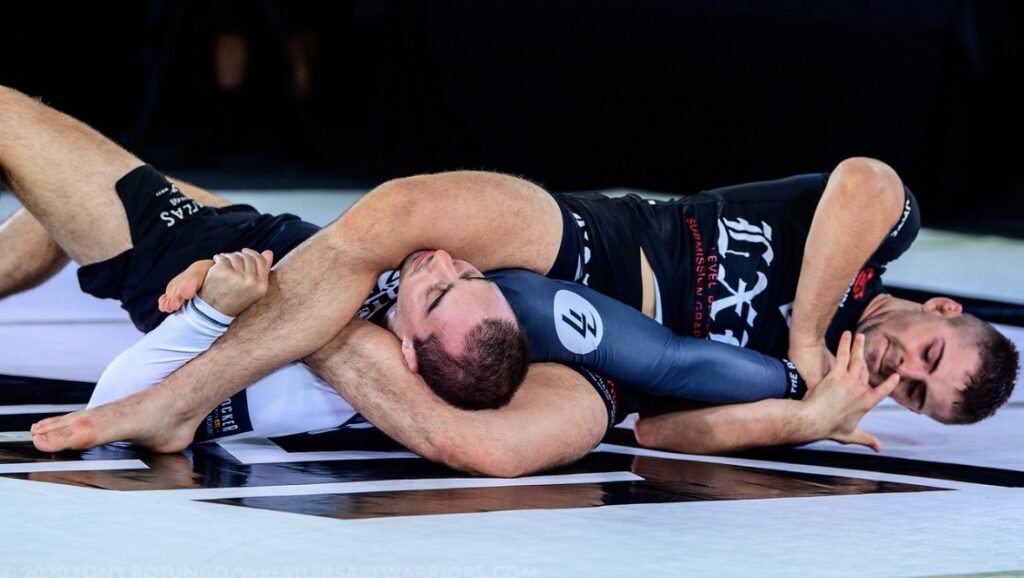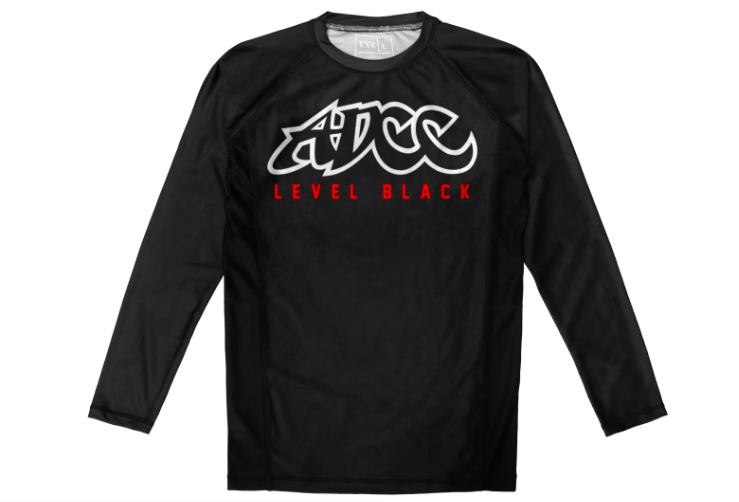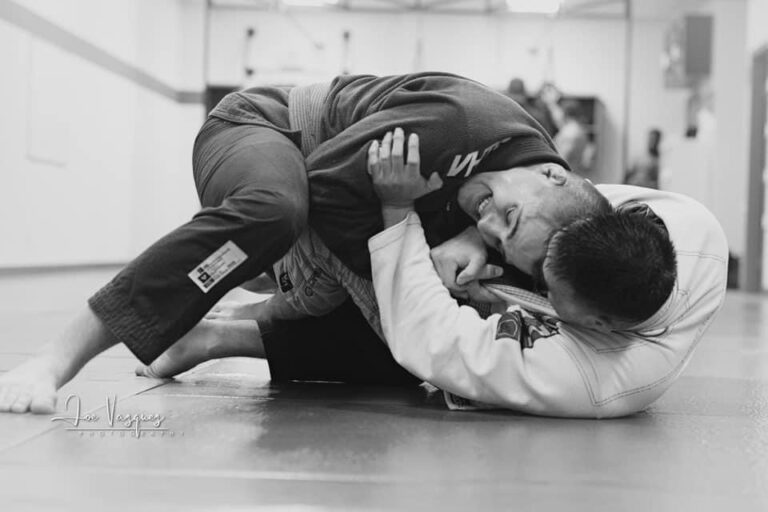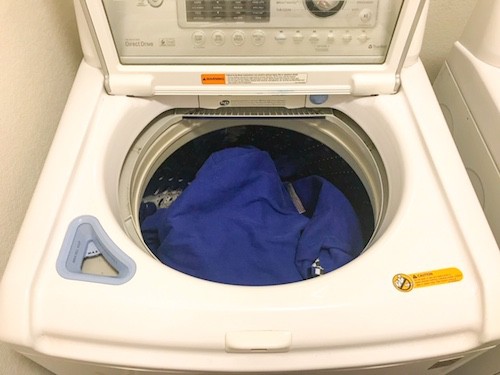BJJ Rash Guards: How To Choose and Care For Rash Guards

Jiu-Jitsu involves a lot of skin-to-skin and skin-to-mat contact. As a result, chafing, abrasions, mat burns, and skin infections are commonplace in this combat sport. Many BJJ players choose to protect themselves by investing in rash guards, which reduce friction, provide compression, and wick away sweat for better performance.
Though some BJJ players choose to wear rash guards under their gi, they are most common in no-gi jiu-jitsu. Since rash guards fit tight to the skin it is less likely that a BJJ player will get their fingers or toes stuck in their rolling partner’s clothing.
What Are Jiu-Jitsu Rash Guards
Rash guards refer to a type of shirt that is typically long-sleeved and skin-tight. They are designed to hug the body very closely and are intended to be worn by athletes during training or competition bouts.
Rash guards are typically fabricated from spandex, polyester, or nylon. The materials and technology are designed to promote sweat absorption, reduce friction, and leave the athlete feeling free to move and perform uninhibited.
Though jiu jitsu rash guards are mostly thought of as part of the no-gi uniform, there are also benefits of wearing your rash guard in Gi jiu-jitsu as well.
You can purchase both long-sleeved and short-sleeved Jiu-Jitsu rash guards. There are pros and cons to each but it is mostly a difference in preference. You can read about the pros and cons of each here!
Should You Wear Rash Guards Under Your Gi?
Because BJJ is such a physically taxing sport and tends to include a lot of sweat, people often ask me if they should wear rash guards and spats under their BJJ gi.
It is best to wear spats and rash guards under your BJJ gi. Wearing them will greatly reduce sweating and decrease the likelihood of suffering a sweat rash, friction burn, or contracting a skin infection.
Wearing spats and rash guards also provides compressive muscular support. Though your gi prevents contact with the skin, the rash guard can help absorb your sweat and keep it reduce the sweat on your gi and the mats.
Many people think that spats and rash guards keep an athlete dry and sweat-free and don’t do much else, but this is a false presumption. Spats and rash guards offer multiple benefits besides rash protection, many of which are especially applicable to BJJ players and competitions.
Why BJJ Rash Guards Are Important
During BJJ grappling sessions, opponents practice a wide range of techniques, from joint holds to takedowns. There is a lot of movement and physical contact, so the skin must be protected.
Rashguards are made of smooth fabrics and protect the skin from chafing, cuts, scrapes, abrasions, burns, and infections like staph and ringworm. These athletic shirts were initially designed for surfers but have seen increased popularity among martial artists, including those who practice BJJ.
Rashguards essentially create a barrier between you and your opponent’s skin and between you and the mat.
BJJ Rash Guards Prevent Sweat Rashes and Skin Infections
Staph infection is a type of bacterial infection that spreads through sweat and skin-on-skin contact. Staph infections range in severity from very minor to extremely serious, and in the worst cases, can cause blood poisoning and even death.
Another common skin infection in grappling sports is ringworm. Rashguards and spats will help prevent the spread of both ringworm and staph infections.
Of course, if you have a skin infection then you should stay away from the mats until healed. That said, you never know if your teammates or classmates are hoping on the mats with a skin infection.
By wearing a rash guard you will greatly reduce the amount of sweat transferred between yourself and your opponent when rolling. Eliminating all skin-to-skin contact save for the hands, feet, and head.
Not only will rash guards help to prevent staph, but they will also reduce the friction on your skin and help prevent general sweat rashes and friction burns.
Rash Guards Provide Your Muscles With Compressive Support
Because of their tight and compressive materials, wearing a rash guard will provide you with muscular support.
As explained at the onset of this article, jiu-jitsu rash guards are designed to hug the body and be worn tight. Spats and rash guards have somewhat of an elastic nature to them.
They lightly compress the muscles the way that wearing knee sleeves or elbow sleeves does. This will help to support the athlete’s core, joints, and muscles.
While they actually won’t increase your strength in any noticeable way, having everything feel tight and braced will help regulate body temperatures and help protect you from muscle sprains.
Jiu-Jitsu Rash Guards Help Regulate Body Temperature
One of the most distracting and annoying occurrences that a BJJ player can encounter is sweat running in their face, eyes, or palms of their hands and impeding their performance. Rash guards will move the sweat away from your skin and allow it to absorb and escape from the material while the surface of your skin remains cool and dry.
Wearing a rash guard will keep you much dryer all around because they not only absorb sweat effectively but also keep you cool, which will help you to sweat less in the first place.
Furthermore, wearing a BJJ rash guard can help prevent your body from overheating during a match and will, in turn, allow you to preserve more energy and fatigue less quickly.
When worn under your gi rash guards help you to keep your gi clean. Since your gi is not absorbing as much sweat it will stay cleaner and last longer. Polyester spats/rash guards, in particular, have a very high level of breathability and sweat-wicking.
How Tight Should Rash Guard Fit?
BJJ rash guards should fit right up against your skin but not overly tight. You should be able to pinch the material together. It should feel tight but not restrictive. In other words, it should fit tight but not so tight that it is hard to put on and take off.
If your rash guard is loose, it can’t protect you as well, and it may slip around on your body when you grapple. You might not get a burn from the mat, but the fabric of your rashguard can give you a rash if it’s too loose.
The best fit is one that will stretch out an inch or so from your body when you pull it, but instantly revert when you let go. You want to be able to move freely and have the rashguard move with your body, not against it.
If it’s so tight it’s cutting off your circulation, or you can’t move your joints all the way, then you need to go up a size.
What Are BJJ Rash Guards Made Of?
Most rashguards are composed of a synthetic blend of fibers, and each combination of materials has its own characteristics. Some rashguards are even treated with antimicrobial and antifungal agents to protect your skin further during BJJ grappling sessions.
Below are some of the most popular fabrics for rashguards.
Nylon-Spandex
Nylon-spandex blends offer stretch, breathability, and a tight fit. Despite the tightness, nylon spandex is considered superior to other rashguard fabrics because of its comfort and quick-drying abilities.
In addition, nylon-spandex blends resist shrinking and quickly regain their shape, thanks to their elasticity.
Polyester
Some BJJ fighters find nylon spandex to be too tight and restrictive, so they opt for polyester instead.
Polyester is an excellent substitute for nylon spandex and provides similar benefits. This fabric is breathable, moisture-wicking, and water-resistant. It does not, however, offer the same level of stretch and flexibility as spandex blends.
Polyester is the most popular fabric for rash guards and is relatively inexpensive.
Lycra
Lycra fiber and spandex are the same things; Lycra is simply a brand of spandex. Rashguards made of Lycra are very durable, prevent chafing, dry quickly, are breathable, and provide extreme stretch. However, the more Lycra a rashguard contains, the more expensive it will be.
What To Look For in a Jiu-Jitsu Rash Guard

Material is important, but there are other things to look for when choosing a rashguard for BJJ. The following characteristics are indicative of a higher-quality rashguard:
- Double-stitching – Quality rashguards will have at least a double-stitch at the seams. The best rashguards will have anywhere from three to five stitches.
- Extra threads – Whenever possible, opt for a rashguard that has more threads. The more threads, the stronger the hold—and a stronghold is necessary for combat.
- Flatlock seams – Standard overlock seams rub against the skin, creating friction and, as a result, discomfort. Flatlock seams are stitched on top of one another, allowing the seam to lie flat against the skin. These are ideal for BJJ rashguards, as they reduce chafing and friction burns.
- Weighty material – Your rashguard doesn’t have to be super heavy, but it should have some noticeable weight to it. Thin, flimsy rashguards put you at a disadvantage because they’re easily grabbed onto and stretched during grappling sessions.
- Tight fit – Rashguards should fit pretty tightly and should feel almost like a second skin without being restrictive or constrictive. If it fits tight but feels uncomfortable, you might need to go up a size or opt for a stretchier material.
- Raglan sleeves – Set-in sleeves are acceptable but may create friction under the arms. Raglan sleeves provide more space at the armpits. This allows for better flexibility and movement.
How Do You Wash and Take Care of a BJJ Rash Guard?
Taking care of your BJJ rash guard can make it last much longer than you might think. Refusing to wash and care for it will make it smell terrible and fall apart. The good news is it’s quite easy to protect the rash guard and keep it looking like it was brand-new.
How To Wash Rash Guards In 5 Simple Steps
- Wash your rash guard in a laundry machine with similar clothing. We recommend steering clear of adding cotton or linen to the cycle since they’re prone to shedding. The last thing you want is a lint-covered rashguard when you remove it from the dryer.
- Use a small amount of mild detergent to prevent discoloration and deterioration. Dyes and powerful formulas can wreak havoc on your BJJ rashguards, so check the description before getting it. You only need about half of the recommended amount to get the best results.
- Always soak your BJJ rash guard in cold water to prevent the fabric from loosening, discoloring, or shrinking. Warm or hot water can damage your rash guard. Printed logos or low-end fabrics are no match for a few hot cycles (or, much worse, the dryer).
- Hang dry the rash guard rather than putting it in the drying machine. It’s best to hang your rashguard and other BJJ clothing out of direct sunlight. The sun can bleach the colors. Synthetic fabrics dry rather quickly, so your rash guard likely won’t need more than an hour or so on the line outside.
- Proper storage of your BJJ gear can make it last much longer. Hang it rather than leaving it crumpled in your gym bag or on the floor. If you don’t want to forget it, you can fold it into a square and set it on top of the bag. Crumpling your BJJ rash guard will leave creases and make it harder to dry.
How Do You Get the Smell Out of Rash Guards?
Even when washed in a laundry cycle BJJ rash guards can develop an order. So, how do you get rid of the smell in your BJJ rash guard?
- Toss the rash guard into a bucket of cold water with a couple of cups of white vinegar. We suggest using cold water for the same reasons mentioned above, but also because it helps the odors escape from the fabric. White vinegar is anti-bacterial and fights countless odors.
- Add a few drops of mild detergent or dish soap. Dish soap is very effective, but don’t use too much, or it’ll be very difficult to rinse out. Whether you use detergent or soap, you should use a fraction of the amount you use in a laundry cycle. There’s a lot less water in a five-gallon bucket to dilute the detergent.
- Scrub the rash guard against itself. This step is crucial because it removes surface debris and bacteria from the fabric. Pay extra attention to sweat stains or drink spills that might’ve discolored the rashguard. Once it looks clean, proceed to the next step in the process.
- Rinse the soap and vinegar off of the fabric. A rinsing cycle is easy if you’re using a five-gallon bucket. Hold the rashguard in the bucket with your hand, dump the dirty water, and fill the bucket with cold or lukewarm water. Agitate the rashguard and repeat this cycle one more time to remove excess suds.
- Store your rash guards with silica packets to prevent mold, bacteria, and mildew. Silica packets prevent moisture from building on your clothes. You can try the Dry & Dry 5-Gram Silica Packets. Toss one of these packets in your gym bag and replace it once per week.
How Often Should You Wash a BJJ Rash Guard?
You should wash a BJJ rash guard after every use. Whether you train once per week or twice a day, your rashguard needs to be cleaned; Otherwise, it can grow bacteria that ruin its durability, color, smell, and more.
Though BJJ rash guards help protect against ringworm and staph this is not the case if rash guards are dirty. Clean rash guards help keep you and your training partner safe.
Tips to Make a Rash Guard Last Longer
If you want to save money and keep your rash guards lasting for a long time, you’re in the right place. Some people replace their BJJ gear far too often, sometimes every 6 to 12 months. If your rash guard doesn’t last at least a couple of years, there are improvements to be made.
Let’s explore what you can do to get the most longevity out of your BJJ rash guard.
Wash Your Rash Guard Inside-Out
Turning a rashguard inside-out will stop the dyes from leaching, which is a significant sign of aging fabric. You can use this tip for almost any clothes in your wardrobe. Another reason it’s best to turn the rash guard inside-out before washing is most of the sweat comes from inside the clothing rather than the outside.
Wash Your Rash Guards With Quality Detergents
It might be tempting to use whatever you have at home to wash your BJJ rash guards. Unfortunately, this is a costly mistake that can ruin a rash guard long before it should’ve been thrown in the trash. Harsh soaps and detergents can loosen the fabric, causing strings to pull out of it while the colors fade away.
Preserving your rash guard starts with proper washing cycles and ends with storage. If you follow the tips for storage and cleaning, you’ve done everything you can to care for your BJJ rash guard.
Many people find it easy to make their gear last for many years, saving time, money, and headaches.





